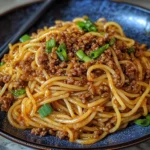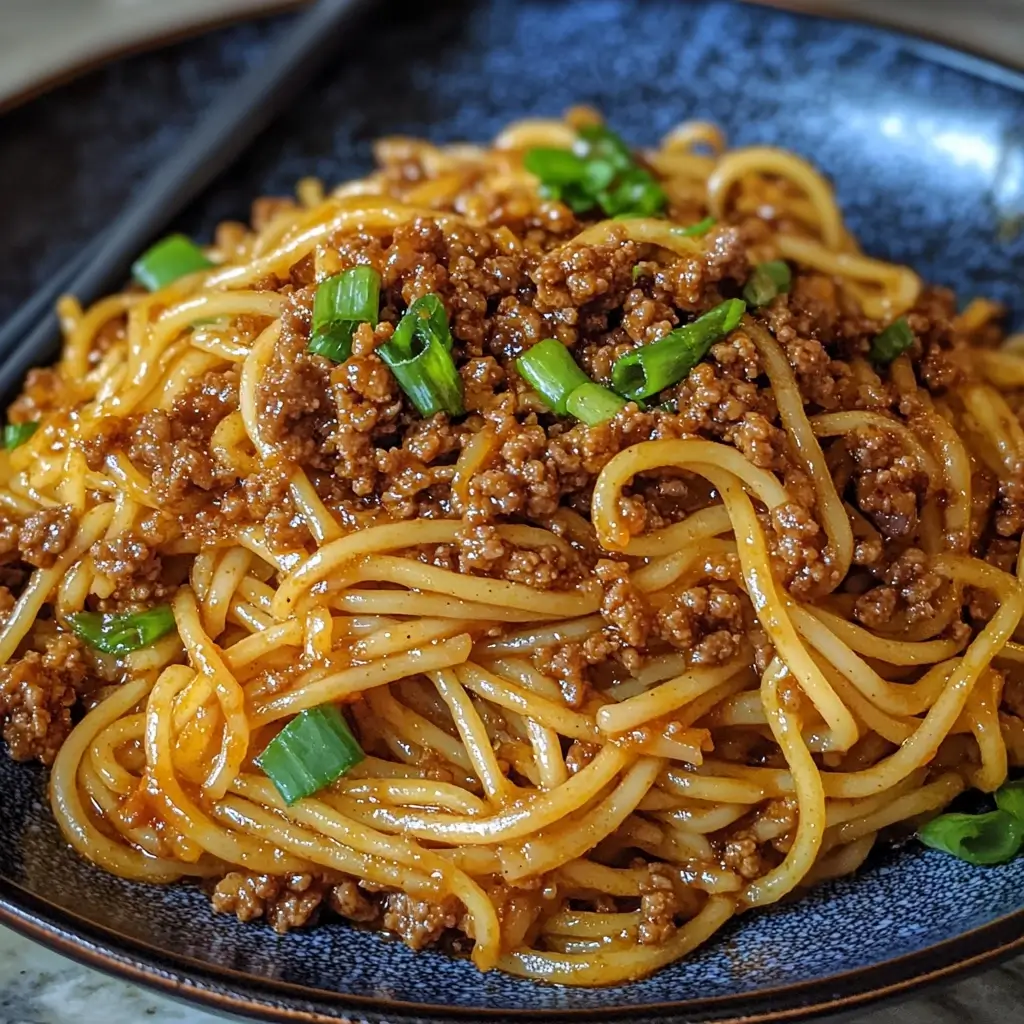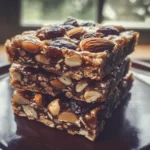In the whirlwind of busy weeknights, finding a meal that’s both quick to prepare and genuinely exciting for the whole family can feel like searching for a culinary unicorn. For years, I’ve been on that quest, experimenting with countless recipes that promised speed and flavor, often falling short on one or the other. That is, until I stumbled upon this Asian Ground Beef Noodles recipe. From the first sizzle in the pan to the last satisfying slurp, this dish has become a staple in our home. The aroma alone is enough to draw everyone to the kitchen, and the taste? Let’s just say empty bowls and requests for seconds are the norm. Even my pickiest eater, who usually approaches anything vaguely “Asian-inspired” with suspicion, devours this with gusto. It’s the perfect balance of savory, slightly sweet, and undeniably comforting, making it a weeknight winner that I’m thrilled to share with you.
Ingredients
This recipe shines because it uses readily available ingredients, many of which you might already have in your pantry and refrigerator. The beauty of this dish also lies in its flexibility – feel free to adjust vegetable quantities or swap proteins to suit your preferences and what you have on hand. High-quality ingredients, especially when it comes to soy sauce and noodles, will significantly elevate the final flavor profile.
For the Ground Beef:
- 1 pound ground beef (80/20 blend recommended for flavor, but leaner works too) – The star of the show, ground beef provides a hearty and satisfying base. Opt for a good quality ground beef for the best taste. For a healthier option, you can use ground turkey or chicken.
- 1 tablespoon vegetable oil – Essential for browning the ground beef and sautéing the aromatics. Canola oil or avocado oil are also good substitutes.
- 1 medium yellow onion, finely chopped – Adds sweetness and depth of flavor to the base of the sauce. White onion or shallots can be used as alternatives.
- 2 cloves garlic, minced – A cornerstone of Asian cuisine, garlic provides a pungent and savory aroma. Freshly minced garlic is highly recommended for the best flavor.
- 1 tablespoon fresh ginger, minced – Ginger adds a warm, zesty kick that brightens the dish and complements the other flavors beautifully. If using ground ginger, start with 1 teaspoon and adjust to taste.
- 1 red bell pepper, thinly sliced – Adds sweetness, color, and a slight crunch. You can substitute with other bell pepper colors or use different vegetables like carrots or broccoli florets.
- Optional: 1 jalapeño, finely minced (for heat) – If you like a bit of spice, jalapeño adds a pleasant warmth. Remove seeds for less heat, or use a milder chili like Fresno pepper.
For the Sauce:
- 1/2 cup low-sodium soy sauce – The foundation of the umami-rich sauce. Low-sodium soy sauce allows you to control the saltiness and is generally recommended for a more balanced flavor. Tamari (gluten-free soy sauce) can also be used.
- 1/4 cup brown sugar, packed – Adds sweetness and balances the saltiness of the soy sauce. Light or dark brown sugar works equally well. Honey or maple syrup can be used as substitutes, but may slightly alter the flavor.
- 2 tablespoons rice vinegar – Provides acidity and tanginess, cutting through the richness of the sauce and adding brightness. Apple cider vinegar or white wine vinegar can be used as substitutes in a pinch.
- 1 tablespoon sesame oil – Essential for that authentic Asian flavor. Toasted sesame oil is recommended for its richer aroma and taste.
- 1 tablespoon cornstarch – Used as a thickening agent to create a luscious sauce that coats the noodles and beef beautifully. Arrowroot powder is a good gluten-free alternative.
- 1/4 cup water – Helps to thin out the sauce and allows the flavors to meld together.
For the Noodles and Garnish:
- 1 pound Asian noodles (such as lo mein, chow mein, or spaghetti) – The base of the meal. Lo mein or chow mein noodles are traditionally used and offer a satisfying chew. Spaghetti or linguine can be used as readily available substitutes. Rice noodles are a gluten-free option.
- Optional garnishes:
- Chopped green onions – Adds freshness and a mild oniony bite.
- Sesame seeds – Adds a nutty flavor and visual appeal.
- Red pepper flakes – For an extra kick of heat.
- Fresh cilantro, chopped – Adds a bright, herbaceous flavor.
- Lime wedges – A squeeze of lime juice at the end brightens the dish and adds a final touch of acidity.
Instructions
This recipe is designed for ease and speed, perfect for busy weeknights. Following these step-by-step instructions will ensure you create a delicious and satisfying meal every time. Don’t be intimidated by the number of steps; many can be done simultaneously to save time.
- Prepare the Noodles: Begin by cooking your noodles according to package directions. While the noodles are cooking, you can proceed with the next steps. Drain the noodles thoroughly once cooked and set aside. Tossing them with a little sesame oil can prevent them from sticking together if they are sitting for a bit.
- Brown the Ground Beef: Heat the vegetable oil in a large skillet or wok over medium-high heat. Add the ground beef and cook, breaking it apart with a spoon, until browned. Drain off any excess grease. Browning the beef is crucial for developing rich flavor, so ensure it’s nicely browned before moving on.
- Sauté Aromatics and Vegetables: Add the chopped onion to the skillet with the browned ground beef and cook until softened, about 3-5 minutes. Then, add the minced garlic and ginger and cook for another minute until fragrant. Be careful not to burn the garlic and ginger, as this can impart a bitter taste. Add the sliced red bell pepper (and jalapeño, if using) and cook for an additional 3-5 minutes, until the peppers are slightly softened but still have a bit of crispness.
- Whisk Together the Sauce: In a small bowl, whisk together the low-sodium soy sauce, brown sugar, rice vinegar, sesame oil, cornstarch, and water until the cornstarch is fully dissolved and the sauce is smooth. Ensure there are no lumps of cornstarch for a silky sauce.
- Combine and Simmer: Pour the sauce over the ground beef and vegetables in the skillet. Bring the mixture to a simmer, stirring constantly, until the sauce thickens and coats the beef and vegetables, about 2-3 minutes. Simmering the sauce allows it to thicken and for the flavors to meld together beautifully.
- Add Noodles and Toss: Add the cooked and drained noodles to the skillet with the sauce and ground beef mixture. Toss everything together until the noodles are evenly coated with the sauce and heated through. Ensure the noodles are well-coated for maximum flavor in every bite.
- Serve and Garnish: Serve the Asian Ground Beef Noodles immediately while hot. Garnish with your desired toppings, such as chopped green onions, sesame seeds, red pepper flakes, fresh cilantro, and lime wedges. Garnishes not only enhance the visual appeal but also add layers of flavor and texture to the dish.
Nutrition Facts
Understanding the nutritional content of your meals can be helpful for making informed dietary choices. Please note that these are approximate values and can vary based on specific ingredients used and portion sizes.
Servings: 6
Approximate Nutrition Facts Per Serving:
- Calories: 450-550 kcal
- Protein: 30-35g
- Fat: 20-25g
- Saturated Fat: 8-10g
- Cholesterol: 90-110mg
- Sodium: 800-1000mg (can be lower with reduced sodium soy sauce)
- Carbohydrates: 45-55g
- Fiber: 3-5g
- Sugar: 10-15g
These values are estimates and may vary depending on the specific ingredients used, brand variations, and portion sizes. Using leaner ground beef, whole wheat noodles, and increasing vegetable content can help reduce fat and increase fiber content.
Preparation Time
One of the biggest advantages of this Asian Ground Beef Noodles recipe is its speed and efficiency. From start to finish, you can have a delicious and satisfying meal on the table in under 30 minutes.
- Prep Time: 15 minutes (chopping vegetables, mincing aromatics, measuring sauce ingredients)
- Cook Time: 15 minutes (cooking beef, sautéing vegetables, simmering sauce, cooking noodles – some of which can be done concurrently)
- Total Time: 30 minutes
This quick preparation time makes it an ideal choice for busy weeknights when you need a flavorful and satisfying meal without spending hours in the kitchen.
How to Serve
Asian Ground Beef Noodles are delicious on their own, but you can elevate the dining experience with thoughtful serving suggestions and accompaniments.
- Garnish Options (Choose one or a combination):
- Fresh Herbs: Chopped cilantro, Thai basil, or mint add a refreshing and aromatic touch.
- Crunchy Toppings: Toasted sesame seeds, chopped peanuts, or crispy fried onions provide textural contrast.
- Spice Boost: Red pepper flakes, sriracha, or chili garlic sauce for those who like it hot.
- Freshness: Thinly sliced green onions or scallions for a mild oniony bite and visual appeal.
- Citrus Zing: Lime wedges or lemon wedges to squeeze over the noodles for a final burst of acidity.
- Side Dish Pairings:
- Steamed Vegetables: Broccoli, bok choy, or snap peas provide a healthy and light counterpoint to the richness of the noodles.
- Spring Rolls or Egg Rolls: Crispy spring rolls or egg rolls offer a classic Asian appetizer pairing.
- Kimchi or Pickled Vegetables: Adds a tangy and spicy element to complement the savory noodles.
- Simple Salad: A light and refreshing cucumber salad or mixed greens salad with a vinaigrette dressing.
- Miso Soup: A warm and comforting miso soup to start the meal.
- Drink Pairings:
- Green Tea: A classic and refreshing pairing with Asian cuisine.
- Light Beer: A crisp lager or pilsner complements the savory flavors without overpowering them.
- Sake: A traditional Japanese rice wine that pairs well with Asian dishes.
- Sparkling Water with Lime: A light and refreshing non-alcoholic option.
- Iced Tea: Unsweetened iced tea provides a cool and neutral beverage.
Additional Tips
To ensure your Asian Ground Beef Noodles are a resounding success every time, consider these helpful tips and tricks gleaned from years of making this recipe.
- Tip 1: Don’t Overcook the Noodles: Overcooked noodles can become mushy and detract from the texture of the dish. Cook noodles al dente according to package directions, and drain them immediately. Rinsing them in cold water can also help stop the cooking process and prevent stickiness, especially if using starchy noodles like spaghetti.
- Tip 2: Taste and Adjust Seasoning: Soy sauce brands vary in saltiness, and personal preferences for sweetness and spice differ. Always taste the sauce before adding the noodles and adjust seasoning as needed. Add more soy sauce for saltiness, brown sugar for sweetness, rice vinegar for tanginess, or red pepper flakes for heat.
- Tip 3: Prep Ingredients in Advance: This recipe comes together quickly, but prepping your ingredients beforehand (chopping vegetables, mincing aromatics, measuring sauce ingredients) will make the cooking process even smoother and faster, especially on busy weeknights. This mise en place approach is key to efficient cooking.
- Tip 4: Customize Your Vegetables: Feel free to swap out or add other vegetables based on your preferences and what’s in season. Broccoli florets, sliced carrots, snow peas, mushrooms, baby corn, or even spinach can be great additions. Add heartier vegetables like carrots and broccoli earlier in the cooking process so they have time to soften.
- Tip 5: Make it Spicy or Mild: Control the spice level by adjusting the amount of jalapeño or red pepper flakes. For a milder dish, omit the jalapeño and red pepper flakes entirely. For extra heat, add a dash of sriracha or chili garlic sauce to the sauce or as a garnish. You can also offer a chili oil or sambal oelek on the side for those who want to add their own level of spice.
FAQ Section
Here are some frequently asked questions about making Asian Ground Beef Noodles, to help you troubleshoot and customize the recipe to your liking.
Q1: Can I use different types of noodles?
A: Absolutely! While lo mein or chow mein noodles are traditional, you can easily substitute with other Asian noodles like udon, ramen, or even rice noodles for a gluten-free option. Spaghetti or linguine also work well as readily available alternatives. Just be sure to cook the noodles according to package directions and adjust cooking time accordingly.
Q2: Can I make this recipe vegetarian or vegan?
A: Yes, you can easily adapt this recipe for vegetarian or vegan diets. Substitute the ground beef with crumbled firm tofu, tempeh, or plant-based ground meat alternatives. Ensure your soy sauce is vegan (some may contain honey). For a vegan version, double-check all your sauce ingredients and garnishes are plant-based, and consider adding extra vegetables or mushrooms for heartiness.
Q3: How long do leftovers last and how do I reheat them?
A: Leftover Asian Ground Beef Noodles can be stored in an airtight container in the refrigerator for up to 3-4 days. To reheat, you can microwave individual portions until heated through. For larger portions, reheat in a skillet over medium heat with a splash of water or broth to prevent drying out. Noodles tend to absorb sauce upon standing, so you might want to add a little extra soy sauce or water when reheating to restore moisture.
Q4: What if I don’t have rice vinegar? Can I use something else?
A: If you don’t have rice vinegar, you can substitute it with apple cider vinegar or white wine vinegar. These alternatives will provide a similar acidity, though the flavor profile might be slightly different. Start with a slightly smaller amount and adjust to taste, as these vinegars can be a bit stronger than rice vinegar.
Q5: Can I make this recipe ahead of time?
A: While this dish is best served fresh, you can prepare components ahead of time to save time on busy days. You can cook the ground beef mixture and prepare the sauce separately a day in advance and store them in the refrigerator. Cook the noodles fresh just before serving and then combine everything together. Adding the noodles right before serving prevents them from becoming soggy in the sauce. You can also chop all your vegetables and aromatics ahead of time and store them in the refrigerator to streamline the cooking process.
Print
Asian Ground Beef Noodles Recipe
Ingredients
For the Ground Beef:
- 1 pound ground beef (80/20 blend recommended for flavor, but leaner works too) – The star of the show, ground beef provides a hearty and satisfying base. Opt for a good quality ground beef for the best taste. For a healthier option, you can use ground turkey or chicken.
- 1 tablespoon vegetable oil – Essential for browning the ground beef and sautéing the aromatics. Canola oil or avocado oil are also good substitutes.
- 1 medium yellow onion, finely chopped – Adds sweetness and depth of flavor to the base of the sauce. White onion or shallots can be used as alternatives.
- 2 cloves garlic, minced – A cornerstone of Asian cuisine, garlic provides a pungent and savory aroma. Freshly minced garlic is highly recommended for the best flavor.
- 1 tablespoon fresh ginger, minced – Ginger adds a warm, zesty kick that brightens the dish and complements the other flavors beautifully. If using ground ginger, start with 1 teaspoon and adjust to taste.
- 1 red bell pepper, thinly sliced – Adds sweetness, color, and a slight crunch. You can substitute with other bell pepper colors or use different vegetables like carrots or broccoli florets.
- Optional: 1 jalapeño, finely minced (for heat) – If you like a bit of spice, jalapeño adds a pleasant warmth. Remove seeds for less heat, or use a milder chili like Fresno pepper.
For the Sauce:
- 1/2 cup low-sodium soy sauce – The foundation of the umami-rich sauce. Low-sodium soy sauce allows you to control the saltiness and is generally recommended for a more balanced flavor. Tamari (gluten-free soy sauce) can also be used.
- 1/4 cup brown sugar, packed – Adds sweetness and balances the saltiness of the soy sauce. Light or dark brown sugar works equally well. Honey or maple syrup can be used as substitutes, but may slightly alter the flavor.
- 2 tablespoons rice vinegar – Provides acidity and tanginess, cutting through the richness of the sauce and adding brightness. Apple cider vinegar or white wine vinegar can be used as substitutes in a pinch.
- 1 tablespoon sesame oil – Essential for that authentic Asian flavor. Toasted sesame oil is recommended for its richer aroma and taste.
- 1 tablespoon cornstarch – Used as a thickening agent to create a luscious sauce that coats the noodles and beef beautifully. Arrowroot powder is a good gluten-free alternative.
- 1/4 cup water – Helps to thin out the sauce and allows the flavors to meld together.
For the Noodles and Garnish:
- 1 pound Asian noodles (such as lo mein, chow mein, or spaghetti) – The base of the meal. Lo mein or chow mein noodles are traditionally used and offer a satisfying chew. Spaghetti or linguine can be used as readily available substitutes. Rice noodles are a gluten-free option.
- Optional garnishes:
- Chopped green onions – Adds freshness and a mild oniony bite.
- Sesame seeds – Adds a nutty flavor and visual appeal.
- Red pepper flakes – For an extra kick of heat.
- Fresh cilantro, chopped – Adds a bright, herbaceous flavor.
- Lime wedges – A squeeze of lime juice at the end brightens the dish and adds a final touch of acidity.
Instructions
- Prepare the Noodles: Begin by cooking your noodles according to package directions. While the noodles are cooking, you can proceed with the next steps. Drain the noodles thoroughly once cooked and set aside. Tossing them with a little sesame oil can prevent them from sticking together if they are sitting for a bit.
- Brown the Ground Beef: Heat the vegetable oil in a large skillet or wok over medium-high heat. Add the ground beef and cook, breaking it apart with a spoon, until browned. Drain off any excess grease. Browning the beef is crucial for developing rich flavor, so ensure it’s nicely browned before moving on.
- Sauté Aromatics and Vegetables: Add the chopped onion to the skillet with the browned ground beef and cook until softened, about 3-5 minutes. Then, add the minced garlic and ginger and cook for another minute until fragrant. Be careful not to burn the garlic and ginger, as this can impart a bitter taste. Add the sliced red bell pepper (and jalapeño, if using) and cook for an additional 3-5 minutes, until the peppers are slightly softened but still have a bit of crispness.
- Whisk Together the Sauce: In a small bowl, whisk together the low-sodium soy sauce, brown sugar, rice vinegar, sesame oil, cornstarch, and water until the cornstarch is fully dissolved and the sauce is smooth. Ensure there are no lumps of cornstarch for a silky sauce.
- Combine and Simmer: Pour the sauce over the ground beef and vegetables in the skillet. Bring the mixture to a simmer, stirring constantly, until the sauce thickens and coats the beef and vegetables, about 2-3 minutes. Simmering the sauce allows it to thicken and for the flavors to meld together beautifully.
- Add Noodles and Toss: Add the cooked and drained noodles to the skillet with the sauce and ground beef mixture. Toss everything together until the noodles are evenly coated with the sauce and heated through. Ensure the noodles are well-coated for maximum flavor in every bite.
- Serve and Garnish: Serve the Asian Ground Beef Noodles immediately while hot. Garnish with your desired toppings, such as chopped green onions, sesame seeds, red pepper flakes, fresh cilantro, and lime wedges. Garnishes not only enhance the visual appeal but also add layers of flavor and texture to the dish.
Nutrition
- Serving Size: one normal portion
- Calories: 450-550
- Sugar: 10-15g
- Sodium: 800-1000mg
- Fat: 20-25g
- Saturated Fat: 8-10g
- Carbohydrates: 45-55g
- Fiber: 3-5g
- Protein: 30-35g
- Cholesterol: 90-110mg





